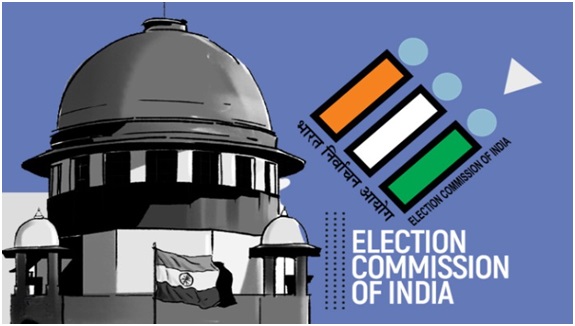Allocation of Election Symbols to Political Parties in India (Indian Express)

- 24 Oct 2023
Why is it in the News?
- The Supreme Court declined to hear a petition that the ruling Telangana's Bharat Rashtra Samiti (BRS) party filed challenging the attribution of election symbols to two other parties.
- BRS contended that the symbols 'road roller' and 'chapatti roller' given to 'Yuga Thulasi Party' and 'Alliance of Democratic Reforms Party' resembled BRS's car symbol, potentially causing confusion among voters during elections.
- The Supreme Court declined the petition, expressing confidence in voters' ability to distinguish between the symbols.
How are Election Symbols Allotted to Political Parties in India?
- The Election Commission of India (ECI) is responsible for symbol allotment, operating under The Election Symbols (Reservation and Allotment) Order, 1968.
- This order aims to specify, reserve, choose, and allocate symbols for elections in Parliamentary and Assembly Constituencies, primarily for recognized political parties.
- Symbols can be either reserved for exclusive use by recognized political parties or 'free' for unrecognised registered parties.
- Unrecognized registered parties or candidates can choose from 'free' symbols because they have not secured enough percentage of votes to fulfill the prescribed criteria to become a recognised party.
- Once selected by parties, these symbols become 'free' for others to choose in subsequent elections.
- Recognized national and state parties receive exclusive symbols.
- For instance, the Samajwadi Party leader Mulayam Singh Yadav chose the symbol of a bicycle for the 1993 Uttar Pradesh Assembly polls.
- The ECI announces party symbols through notifications published in the Gazette of India.
- As per recent notifications, there are six national parties, 26 state parties, and 2,597 registered unrecognised parties in India.
Do political parties get to state their preferences?
- The 1968 order empowers the Election Commission (EC) to manage the specification, reservation, choice, and allocation of symbols for parliamentary and assembly elections, particularly for recognizing political parties.
- Unregistered parties are required to provide a list of ten symbols in order of preference from the set of free symbols published by the EC.
- Parties have the option to propose up to three new symbols of their choice.
- These proposals should include names and clear designs, ranked in order of preference.
- The EC may consider these proposals for allocation as a common symbol if no objections arise.
- Proposed symbols must not resemble existing reserved or free symbols, have no religious or communal connotations, and should not depict birds or animals.
What happens when a recognised political party splits?
- When a recognised political party splits, the Election Commission takes the decision to assign the symbol.
- For instance, the Congress party, in the first elections of 1952, had a pair of bulls as its symbols. Following splits in the party over the years, the current symbol of hand eventually went to the party.
- More recently, the EC allowed the Eknath Shinde faction of the Shiv Sena to retain the party’s traditional bow and arrow symbol, while the Udbhav Tackeray faction was allotted a flaming torch.
- The factions had asked for the trident (Trishul) and the mace (Gada), which were rejected citing religious connotations.
- Both factions had also wanted the ‘rising sun’, which the EC pointed out was the DMK’s election symbol.
- In case of a split, the EC is empowered to decide on the claims of opposing factions under Paragraph 15 of the Symbols Order, 1968.
- After considering all of the relevant information, considering the circumstances of the case, and consulting with the parties' representatives, the EC makes a decision.
- All of these rival sections or groups are bound by the Commission's decision.
- When registered but unrecognized parties split, the ECI usually advises the warring factions to settle their differences internally or go to court.
Sadiq Ali Case
- In the Sadiq Ali v. Election Commission of India (1971), it was decided that in matters of disputes among groups of a political party, the test of majority support among members of the party's "organizational and legislative wings" was the critical test to decide the dispute.
- It includes the Party Constitution Test, Party Constitution Aims and Objectives Test, and Majority Test.
What happens to the faction that doesn't receive the symbol of the parent party?
- Before 1997, the Election Commission recognized the group not obtaining the symbol based on specific criteria defined in Paras 6 and 7 of the Symbols Order.
- This recognition depended on whether the breakaway party had the support of a sufficient number of MPs/MLAs according to those criteria, leading to their recognition as a National or State Party.
- However, in 1997, the Election Commission determined that merely having MPs and MLAs was insufficient.
- This was because these elected representatives had contested and won elections on the tickets of their parent (undivided) parties.
- Consequently, the Election Commission introduced a new rule.
- Under this rule, the splinter group of the party, different from the group that received the party symbol, was required to register itself as a separate political party.
- These newly registered parties could only attain national or state party status based on their performance in elections at the state or central level following their registration.
Registration of Political Parties:
- According to the Election Commission of India (ECI), any party seeking registration must submit an application to the Commission within 30 days of the date of its formation in accordance with the Commission's rules.
- It acts in accordance with Article 324 of the Indian Constitution and Section 29A of the Representation of the People Act, 1951.
- According to Section 29A of the Representation of the People Act of 1951, all political parties must register before participating in elections.
